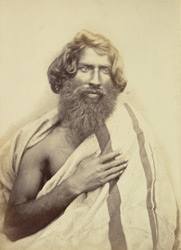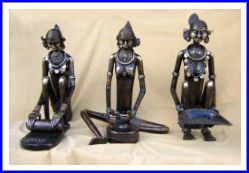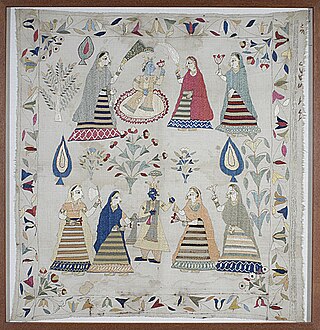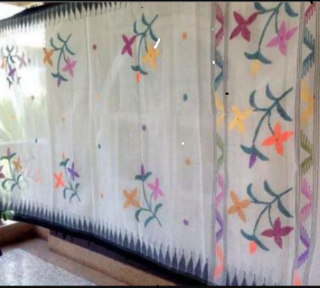
Khurja is a city in Bulandshahr district in the Indian state of Uttar Pradesh. It is situated around 20 km from Bulandshahr, 85 km from Delhi. Khurja supplies a large portion of the ceramics used in the country, hence it is sometimes called The Ceramics City. The city is also famous for its special sweet, known as "khurchan".
The Office of the Controller General of Patents, Designs and Trade Marks(CGPDTM) generally known as the Indian Patent Office, is an agency under the Department for Promotion of Industry and Internal Trade which administers the Indian law of Patents, Designs and Trade Marks.

The economy of Uttar Pradesh is the third largest of all the states in India. Nominal GDP of the state for the year 2022-23 is Rs. 20.48 trillion

The black pottery of Nizamabad in Azamgarh district of Uttar Pradesh, India is unique type of clay pottery known for its dark shiny body with engraved silver patterns. It was registered for Geographical Indication tag in December 2015.

Kangra tea is a tea from the Kangra district in Himachal Pradesh, India. Both black tea and green tea have been produced in the Kangra Valley since the mid-19th century. Kangra tea was given the Geographical Indication status in 2005.

The Thanjavur Art Plate is an artifact which is exclusively made in Thanjavur, Tamil Nadu, India. It is a circular plate made as a gift item. It is a handicraft consisting of metals such as silver, bronze, and copper embossed with figures of gods and goddesses at its center. The artwork has been registered for protection under the Geographical indication of the Trade Related Intellectual Property Rights (TRIPS) agreement. It is listed at item 63 as "Thanjavur Art Plate" of the GI Act 1999 of the Government of India, with registration confirmed by the Controller General of Patents Designs and Trademarks. Only the size of the article is permitted to be different while other metal compositions and particularization have to remain the same as per GI approval.

Sankheda furniture is colourful teak wood furniture of Gujarat, India, treated with lacquer and painted in traditional bright shades of maroon and gold. It is made in Sankheda village and hence its name. The village is located about 45 kilometres (28 mi) from Vadodara.

Odisha Ikat, is a kind of ikat known as Bandhakala and Bandha, a resist dyeing technique, originating from Indian state of Odisha. Traditionally known as "Bandhakala"', "Bandha", '"Bandha of Odisha", it is a geographically tagged product of Odisha since 2007. It is made through a process of tie-dying the warp and weft threads to create the design on the loom prior to weaving. It is unlike any other ikat woven in the rest of the country because of its design process, which has been called "poetry on the loom". This design is in vogue only at the western and eastern regions of Odisha; similar designs are produced by community groups called the Bhulia, Kostha Asani, and Patara. The fabric gives a striking curvilinear appearance. Saris made out of this fabric feature bands of brocade in the borders and also at the ends, called anchal or pallu. Its forms are purposefully feathered, giving the edges a "hazy and fragile" appearance. There are different kinds of bandha saris made in Odisha, notably Khandua, Sambalpuri, Pasapali, Kataki and Manibandhi.
Navalgund durries, geographically tagged in India, are woven durries or a type of Indian rug with geometric designs, birds, and animal designs from Navalgund in Dharwad district of Karnataka, India

The Toda Embroidery, also locally known as "pukhoor", is an art work among the Toda pastoral people of Nilgiris, in Tamil Nadu, made exclusively by their women. The embroidery, which has a fine finish, appears like a woven cloth but is made with use of red and black threads with a white cotton cloth background. Both sides of the embroidered fabric are usable and the Toda people are proud of this heritage. Both men and women adorn themselves with the embroidered cloaks and shawls.

Bastar Wooden Crafts are traditional Indian wooden crafts that are manufactured in the Bastar district of Chhattisgarh state, India. The wood-crafting work has been protected under the Geographical indication (GI) of the Agreement on Trade-Related Aspects of Intellectual Property Rights (TRIPS) agreement. It is listed at item 84 as "Bastar Wooden Craft" of the GI Act 1999 of the Government of India with registration confirmed by the Controller General of Patents Designs and Trademarks.

Kannauj Perfume, also known as Kannauj Ittar, is a traditional Indian perfume manufacture. The perfume production is popular in Kannauj, in the Uttar Pradesh state, India.

The Chamba Rumal or Chamba handkerchief is an embroidered handicraft that was once promoted under the patronage of the former rulers of Chamba kingdom. It is a common item of gift during marriages with detailed patterns in bright and pleasing colour schemes.

Santiniketan Leather Goods are leather products made in Santiniketan and surrounding villages near Kolkata, West Bengal, India. The material used is vegetable tanned leather with art work done by touch dyeing. Its artistic leather bags are popular in foreign markets and are exported to many countries including Japan and the U.S. They are generally made of E. I. Leather from sheepskin and goatskin.
The Surat Zari / Jari Craft is a textile product of Surat district in Gujarat, India, which is made from yarns of silk and cotton mixed with gold, silver or copper. The zari threads are used to make intricate designs by weaving into generally silk fabrics. Its use is extensive in textile industries and handicrafts. The Surat Zari is either woven on cloth or hand embroidered to form fabric borders or used as part on the body of the cloth. The zaris are used in fabrics made in Varanasi and a few other places in Uttar Pradesh, Tamil Nadu, Karnataka and Andhra Pradesh. Banarasi saris made in Varanasi and Kanjivaram Saris of South India use Surat Zari extensively.

Solapur Terry Towel is terry towel weaving or knitting work that are manufactured in the Solapur district of Maharashtra state, India. The terry towel work has been protected under the Geographical indication (GI) of the Agreement on Trade-Related Aspects of Intellectual Property Rights (TRIPS) agreement. It is listed at item 9 as "Solapur Terry Towel" of the GI Act 1999 of the Government of India with registration confirmed by the Controller General of Patents Designs and Trademarks.

Kashmir walnut wood carving is wood carving work that is manufactured in Jammu and Kashmir, India. Walnut carving is protected under the geographical indication (GI) of the Agreement on Trade-Related Aspects of Intellectual Property Rights (TRIPS) agreement. It is listed at item 182 as "Kashmir Walnut Wood Carving" of the GI Act 1999 of the Government of India with registration confirmed by the Controller General of Patents Designs and Trademarks.

Wangkhei Phee is a textile fabric made of white cotton. It is a product which is protected under the GI registration and is made throughout the Indian state of Manipur and is woven by women. The fabric is transparent, has many designs on its body, and is popularly worn by women of Manipur for marriage ceremonies and other festive occasions.
Madurai Sungudi is Design of Madurai in the Indian state of Tamil Nadu, which is an exclusive textile product traditionally produced using tie and dye method by the Saurashtrians who migrated to Madurai under the patronage of King Thirumalai Naicker in the 17th century. The fabric's traditional popular use is as a saree; the fabric is now also used to make shirts, salwars, shawls, handbags, bed sheets and pillow cases. The product has been given protection under the GI registration act.
Bastar Iron Craft is a traditional Indian iron crafts that are manufactured in the Bastar district of Chhattisgarh state, India. The iron-crafting work has been protected under the geographical indication (GI) of the Agreement on Trade-Related Aspects of Intellectual Property Rights (TRIPS) agreement. It is listed at item 82 as "Bastar Iron Craft" of the GI Act 1999 of the Government of India with registration confirmed by the Controller General of Patents Designs and Trademarks.















